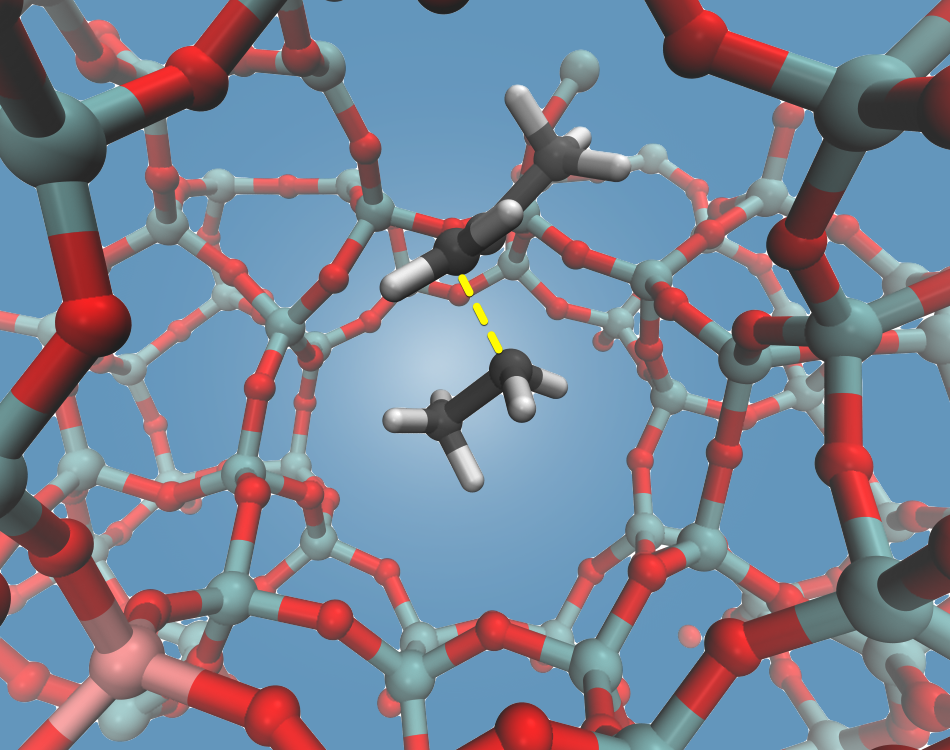First-principle Molecular dynamics study on the isomerization and cracking of alkenes in Brønsted acid zeolites
First-principle Molecular dynamics study on the isomerization and cracking of alkenes in Brønsted acid zeolites
Promotor(en): V. Van Speybroeck /15_NANO06 / Nanoporous materialsAlkene conversions catalyzed by Brønsted-acid zeolites are of paramount importance for the industrial production of transportation fuels (gasoline, diesel, …) and base chemicals such as olefins and paraffins. Alkene cracking in H-ZSM-5 is particularly relevant for both classical FCC processes and emerging alternatives, e.g., the methanol-to-olefins (MTO) process. In both FCC and MTO processes, a considerable fraction of the primary products consists of heavier alkenes, and further cracking of these species is required to achieve high overall ethene and propene yields. Given the importance of these reactions, a profound understanding of the cracking mechanism and kinetics is required to select or design the best catalyst to improve the performance of industrial FCC and MTO plants.
Alkene cracking is generally accepted to occur through -scission of carbenium ion intermediates. However, alkenes are highly reactive and a multitude of side-reactions such as isomerization and oligomerization take place prior to cracking, creating a large and diverse pool of hydrocarbons inside the zeolite pores and resulting in a complex reaction network. Because these side-reactions even occur at low temperatures, detailed information on the individual steps in the reaction network is difficult to obtain from experiments. Theoretical simulations can provide fundamental insights at the molecular level, and aid in understanding experimental observations.

Figure 1. beta-scission of pentyl carbenium ion in H-ZSM-5Objectives In this master thesis, the isomerization and cracking of C4+-alkenes in H-ZSM-5 (Figure 1) will be investigated with advanced molecular modeling techniques. The goal is to identify the prevailing intermediates during a cracking process at elevated temperatures and elucidate the pathways leading to the desired products, i.e., ethene and propene. Molecular dynamics simulations on periodic unit cells will be performed to account for conformational variations of the guest molecules and the flexibility of the zeolite lattice at finite temperatures. State-of-the-art rare-event sampling methods (e.g., metadynamics) will be employed to unravel the underlying mechanisms and to predict the formation rates of the olefin products. The Center for Molecular Modeling has a vast expertise in modeling nanoporous materials, and has access to the extensive computational resources required for studying complex systems of scientific and industrial relevance. The research in this proposal will be conducted in collaboration with an experimental partner providing experimental input for setting up the simulations and for validating the obtained results. The proposed research work is diverse and challenging, and requires creativity and chemical intuition in addition to technical skills, which will be honed throughout the execution of the thesis. Furthermore there will be a close interaction with the researchers working on spectroscopy in nanoporous materials (headed by Prof. K. Hemelsoet).
- Study programmeMaster of Science in Chemical Engineering [EMCHEM]KeywordsHeterogeneous Catalysis, Chemical kinetics, Computational applications

